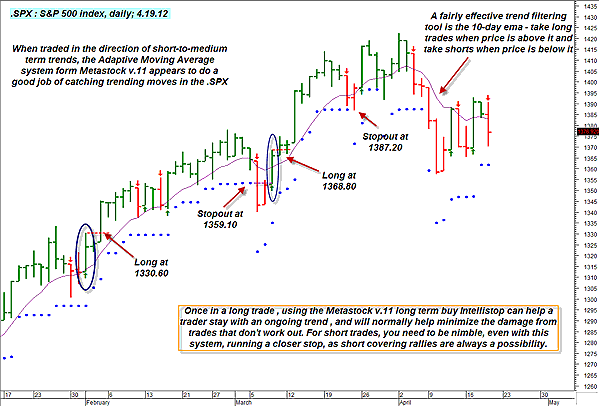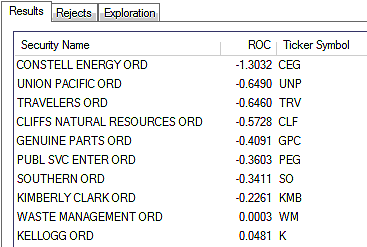
HOT TOPICS LIST
- MACD
- Fibonacci
- RSI
- Gann
- ADXR
- Stochastics
- Volume
- Triangles
- Futures
- Cycles
- Volatility
- ZIGZAG
- MESA
- Retracement
- Aroon
INDICATORS LIST
LIST OF TOPICS
PRINT THIS ARTICLE
by Donald W. Pendergast, Jr.
Trading systems do not need to be expensive or complicated, but traders still need to know when their chances of success are best when relying on one.
Position: N/A
Donald W. Pendergast, Jr.
Donald W. Pendergast is a financial markets consultant who offers specialized services to stock brokers and high net worth individuals who seek a better bottom line for their portfolios.
PRINT THIS ARTICLE
Is .SPX An Effective Trading Model?
04/26/12 08:56:53 AMby Donald W. Pendergast, Jr.
Trading systems do not need to be expensive or complicated, but traders still need to know when their chances of success are best when relying on one.
Position: N/A
| MetaStock 11 comes with dozens of preinstalled trading systems and expert advisors (many of which, even though they can't be backtested, will still plot objective signals on your charts). Here's a look at a simple but apparently effective trend-following system model using a MetaStock 11 version of Perry Kaufman's adaptive moving average system, as applied to the daily price chart of the Standard & Poor's 500. |

|
| FIGURE 1: S&P 500, DAILY. A valid system concept doesn't have to be expensive or complex. The real key to success with any system is your own power of commitment and self-discipline. |
| Graphic provided by: MetaStock. |
| Graphic provided by: Adaptive moving average system from MetaStock 11. |
| |
| With the adaptive moving average system (AMA) signals applied to .SPX's daily chart, it's easy to see that the system issues buy & sell signals on a regular basis, but far more so when the market is in choppy or sideways phases. In fact, the AMA system has fired a total of 15 signals during the past three months. Here's the breakdown: Long signals: There were seven long signals, of which two produced significant winning long trades when used with the long-term IntelliStop buy trailing stops (blue dots on Figure 1). There were two additional long entry signals that fired in the midst of the first long winning trade, which could have been used as add-on or pyramiding opportunities as well. Short signals: There were eight short signals, and of these, only four produced actual triggered entries (an entry would be when the trigger bar's respective high or low is exceeded, depending on whether it was a long or short setup) (see Figure 2). There was only one profitable short trade, and not surprisingly, it happened when the .SPX was trading beneath its 10-period exponential moving average (EMA). Of the other three shorts that triggered, all of them triggered while the .SPX was trading below its 10-period EMA, too. Interestingly, both of the big winning long trades were triggered when the .SPX was trading above its 10-period EMA. Is this an interesting technical dynamic that can help us build a better, more profitable system? After working with this system for a while, here are some of the ideas that I have come up with as to how to make it more profitable and with fewer drawdowns: 1. Take long signals in the .SPX (SPY, emini S&P 500, and so on) only when the long trigger bar makes a daily close above the indexes' 10-period EMA. 2. Buy one or two ticks above the high of the trigger bar if it's a valid setup according to #1 above. 3. If filled on the trade, begin using the MetaStock MS11 IntelliStop buy (long-term) trailing stop and hold the position until finally stopped out. For short trades: 1. Take short signals in the .SPX (SPY, emini S&P 500, and so on) only when the short trigger bar makes a daily close below the indexes' 10-period EMA. 2. Sell one or two ticks below the low of the trigger bar if it's a valid setup according to #1 above. 3. If filled on the trade, begin using the MetaStock MS11 IntelliStop short (short-term) trailing stop and hold the position until finally stopped out. The reason you may not want to use a longer-term stop (that is, a wider stop) on a short position is because of the very real danger of a violent short-covering rally. Long-lasting downtrends in the .SPX occur far less frequently than those of sustained bull market rallies, so consider this as a way to protect more of your hard-won trading profits from needless vaporization on such short-covering reversals. Bottom line: Will this system work out in the real world of trading? Well, in theory, yes, as you would only be taking trades in the direction of the existing short- to medium-term trends and would also be using an objective, nondiscretionary trailing stop to manage the position. However, the real key to success with this or any other trading system is having the mental and spiritual stamina to stick with the system through thick and thin. This means waiting out the inevitable periods of drawdown, letting winning trades run, and closing trades out when your trailing stops tell you it's time to exit. This system concept could be adapted and fine-tuned for nearly any liquid trading instrument, including exchange trading funds (ETFs), stocks, forex, and futures markets, so consider spending some time with this simple system concept and see if you can't improve upon it and make it a valuable part of your trading arsenal. |

|
| FIGURE 2: LARGE-CAP STOCKS. Ten large-cap stocks issuing RMO swing sell signals for April 19, 2012. The first eight are all underperforming the .SPX over the past calendar quarter. |
| Graphic provided by: MetaStock. |
| Graphic provided by: MetaStock Explorer. |
| |
Donald W. Pendergast is a financial markets consultant who offers specialized services to stock brokers and high net worth individuals who seek a better bottom line for their portfolios.
| Title: | Writer, market consultant |
| Company: | Linear Trading Systems LLC |
| Jacksonville, FL 32217 | |
| Phone # for sales: | 904-239-9564 |
| E-mail address: | lineartradingsys@gmail.com |
Traders' Resource Links | |
| Linear Trading Systems LLC has not added any product or service information to TRADERS' RESOURCE. | |
Click here for more information about our publications!
PRINT THIS ARTICLE

|

Request Information From Our Sponsors
- StockCharts.com, Inc.
- Candle Patterns
- Candlestick Charting Explained
- Intermarket Technical Analysis
- John Murphy on Chart Analysis
- John Murphy's Chart Pattern Recognition
- John Murphy's Market Message
- MurphyExplainsMarketAnalysis-Intermarket Analysis
- MurphyExplainsMarketAnalysis-Visual Analysis
- StockCharts.com
- Technical Analysis of the Financial Markets
- The Visual Investor
- VectorVest, Inc.
- Executive Premier Workshop
- One-Day Options Course
- OptionsPro
- Retirement Income Workshop
- Sure-Fire Trading Systems (VectorVest, Inc.)
- Trading as a Business Workshop
- VectorVest 7 EOD
- VectorVest 7 RealTime/IntraDay
- VectorVest AutoTester
- VectorVest Educational Services
- VectorVest OnLine
- VectorVest Options Analyzer
- VectorVest ProGraphics v6.0
- VectorVest ProTrader 7
- VectorVest RealTime Derby Tool
- VectorVest Simulator
- VectorVest Variator
- VectorVest Watchdog
